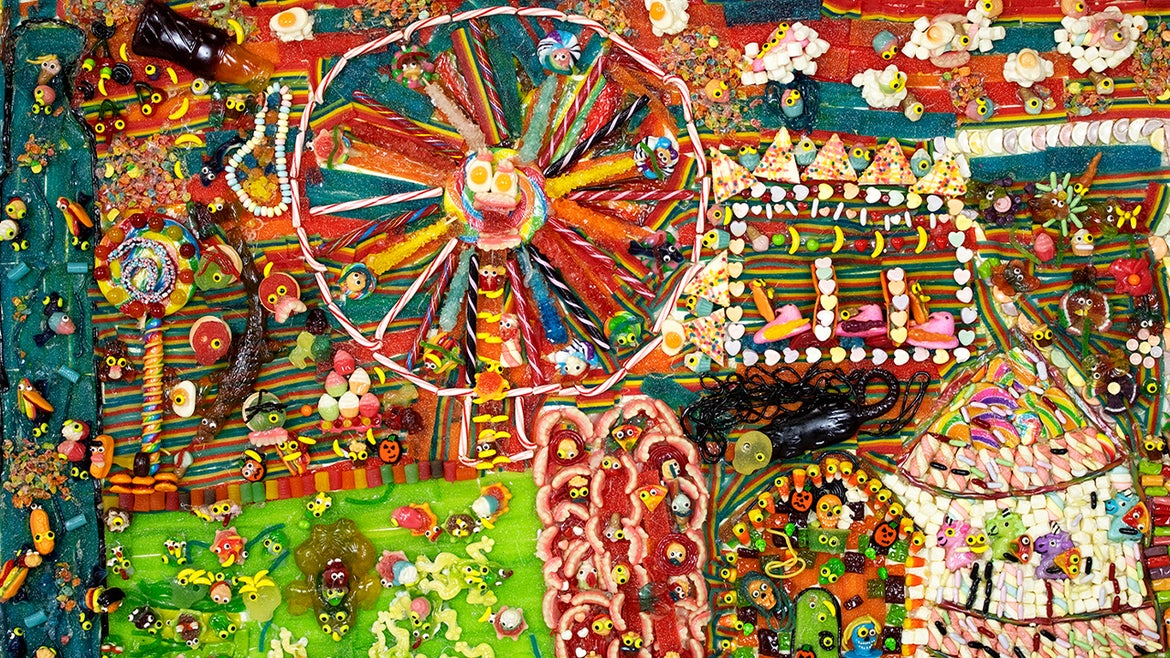The candy replica Ashlea Karkula created was recently sold for $950 and will be donated to a children’s hospital in Minneapolis after it is framed.
Ashlea Karkula spent four months and countless hours hot-gluing more than 1,000 pieces of candy on a 4-by-3-foot canvas to create a candy replica of the Minnesota State Fair Midway.
The 36-year-old artist was born with a developmental disability, and later developed dystonia, a movement disorder where her muscles contract involuntarily. Karkula, who is right-handed had to teach herself how to use her left hand. And, she succeeded in overcoming that obstacle.
Ashlea recently sold her candy replica for $950, $200 above the asking price, and it will be donated to a Children’s Hospital in Minneapolis after it is framed.
Ashlea’s aunt Kathy Karkula told Inside Edition Digital her niece is “very humble, and very shy.”
“They knew how much Ashlea wanted to donate to a children’s hospital with the purpose of making children smile,” Kathy said. ”Ashlea’s intention came through. She works straight from her heart.”
Ashlea told Inside Edition Digital how much she loves the state fair and she loves the Midway since that is where all the games, rides and fun are.
More than 100 pounds of candy were used to create the replica, including gummies, sour worms, sour ropes, smarties, fruit roll-ups, and candy canes, Ashlea explained.
The harder candies, she said, were much easier to manipulate than the softer varieties.
The Ferris wheel, she said was made out of different flavored candy canes, a variety of licorice and Brach’s pinwheels. In order to get the parts of the wheel just right, Ashlea had to spend a good deal of time unwinding the pinwheels to get the strings of licorice she needed.
“I never worked on a canvas that size,” Ashlea said. “It took me a while to figure out what I wanted to do and once I did, I didn’t stop.”
Kathy explained that the candy came from all different places across the United States. “Many of the candies were not in the stores so we sourced a lot of retro candy online."
Ashlea, who lives with her aunt, said she ended up having to move the giant canvas into her sister’s garage after her dog, Talulah, an American pit bull, and Bear, a Yorkie, kept eating the candy whenever she placed a piece on the board.
“It got to be a game,” Ashlea’s aunt laughed.
Ashlea added: “Talulah ate the candy on the top of the canvas and Bear ate the candy on the bottom.”
According to Ashlea, her sister's home is dog-free.
Ashlea, who enjoyed making art when she was a child, was able to really hone her skills and do it professionally after she joined Interact Center for the Visual and Performing Arts, a non-profit organization based in St. Paul, Minn. that works with professional artists with and without disabilities.
Jeanne Calvit founded the organization in 1996, after she "saw a need in society," she tells Inside Edition Digital.
“We were leaving people out because of their disability. They have untapped creativity,” added Calvit, whose organization “challenges disability perceptions.”
“The people with a disability just assume that they should be doing menial labor, some type of assumption, that they will do well in very repetitive work: That is a misconception,” she said. “People who have disabilities, especially, cognitive disabilities, are not creative people. I knew that wasn’t the truth. I saw so many talented people not just in theater, but, writers, artists. People like Ashlea who came to Interact and made spectacular art.”
Calvit added, “It goes back to that feeling you want to do something that is part of your purpose as a human being. Everyone has that need.”
And for the artists and staff, it is also about forming lasting friendships. “A lot of friendships form between our artists. They have a real community here. It is wonderful."
Interact artists get paid for the art they sell. This is their job from 8:30 a.m to 3:30 p.m. each day so they get paid for attendance.
Currently, there are 120 people in the program and a staff of 27. The staffers do not have a disability
Calvit paused, “It's about human potential. We all share that vision. They are all artists and love working together. I had the initial vision but all the staff and all the people who work here believe in their creativity and potential as human beings.”
She added: “There other programs that do visual arts with people with disabilities, but don’t have the same package that we have since we are the only ones in the United States that do theater, visual arts, and literary arts.”
Calvit said that many of their artists who do theater “see the spark of creativity that they never would have expected.”
"Before the artists came to Interact, they felt like they were flawed or something was wrong with them so they felt like they weren't giving back. Now they feel that they have a purpose," Calvit said. "A purpose that they are contributing members of society. And people look up to them now."
Ashlea is currently working on her next candy masterpiece called “Hot Dog Americana.” She is still formatting the idea, but told Inside Edition Digital that it will be hot dogs that all have personalities with American flags on them.






